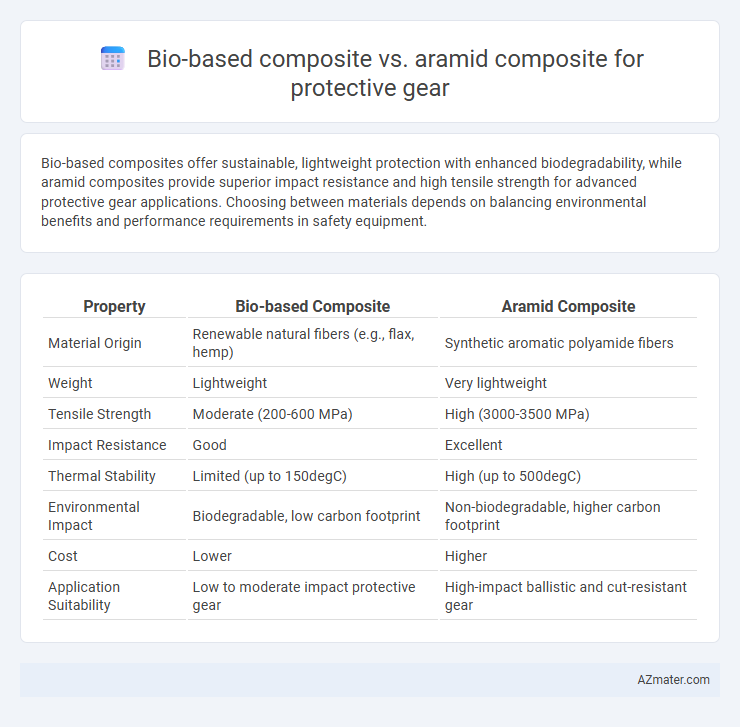Bio-based composites offer sustainable, lightweight protection with enhanced biodegradability, while aramid composites provide superior impact resistance and high tensile strength for advanced protective gear applications. Choosing between materials depends on balancing environmental benefits and performance requirements in safety equipment.
Table of Comparison
| Property | Bio-based Composite | Aramid Composite |
|---|---|---|
| Material Origin | Renewable natural fibers (e.g., flax, hemp) | Synthetic aromatic polyamide fibers |
| Weight | Lightweight | Very lightweight |
| Tensile Strength | Moderate (200-600 MPa) | High (3000-3500 MPa) |
| Impact Resistance | Good | Excellent |
| Thermal Stability | Limited (up to 150degC) | High (up to 500degC) |
| Environmental Impact | Biodegradable, low carbon footprint | Non-biodegradable, higher carbon footprint |
| Cost | Lower | Higher |
| Application Suitability | Low to moderate impact protective gear | High-impact ballistic and cut-resistant gear |
Introduction to Protective Gear Composites
Bio-based composites for protective gear leverage natural fibers combined with biodegradable resins, offering sustainability and reduced environmental impact without compromising moderate impact resistance and lightweight properties. Aramid composites, based on aramid fibers such as Kevlar, exhibit exceptional strength-to-weight ratios, superior ballistic protection, and high resistance to abrasion and heat, making them the gold standard for high-performance protective applications. The selection between bio-based and aramid composites depends on the balance between environmental considerations and the level of protection required in specific safety equipment.
Overview of Bio-Based Composites
Bio-based composites for protective gear consist of natural fibers like hemp, flax, or jute embedded in biodegradable or bio-derived resin matrices, offering sustainable alternatives to synthetic materials. These composites provide lightweight, renewable, and eco-friendly properties with decent mechanical strength and impact resistance suitable for moderate protection levels. Their growing use in helmets, body armor, and protective clothing addresses environmental concerns while balancing performance and cost efficiency compared to traditional aramid composites.
Overview of Aramid Composites
Aramid composites, composed of high-strength synthetic fibers like Kevlar, offer exceptional impact resistance and thermal stability, making them ideal for protective gear such as ballistic vests and helmets. These composites provide superior tensile strength-to-weight ratio and enhanced durability compared to bio-based composites, ensuring reliable protection under extreme conditions. Their widespread use in military and law enforcement applications underscores the material's proven performance in safeguarding against high-velocity threats and sharp objects.
Mechanical Performance Comparison
Bio-based composites for protective gear exhibit competitive tensile strength and improved environmental sustainability compared to aramid composites, which are known for their exceptional impact resistance and high modulus. While aramid composites maintain superior energy absorption and puncture resistance, bio-based materials offer sufficient mechanical performance for less demanding applications with the advantage of biodegradability. The mechanical performance comparison highlights aramid composites as optimal for high-impact protection, whereas bio-based composites present a viable alternative with moderate strength and stiffness.
Weight and Flexibility Analysis
Bio-based composites in protective gear offer a significant weight reduction compared to traditional aramid composites, enhancing mobility and reducing fatigue during extended use. Their inherent flexibility accommodates dynamic movements better, making them suitable for applications requiring high dexterity. Aramid composites, while slightly heavier, provide superior impact resistance and thermal stability, though at the expense of reduced flexibility.
Environmental Impact and Sustainability
Bio-based composites in protective gear offer significant advantages in environmental impact and sustainability due to their renewable raw materials and reduced carbon footprint compared to aramid composites, which rely on petrochemical sources and intensive energy consumption during production. The biodegradable nature of bio-based fibers contributes to lower landfill waste and enhanced end-of-life management, while aramid composites pose challenges in recyclability and generate persistent environmental pollutants. Lifecycle assessments confirm that bio-based composites promote circular economy principles by enabling resource regeneration and minimizing ecological disruption in manufacturing, use, and disposal stages.
Cost Considerations and Market Trends
Bio-based composites offer a cost-effective alternative to aramid composites in protective gear manufacturing, benefiting from lower raw material expenses and increased sustainability appeal. Aramid composites remain preferred for high-performance applications due to superior impact resistance and durability despite higher costs. Market trends indicate growing investment in bio-based materials driven by environmental regulations and consumer demand, while aramid composites maintain strong presence in military and industrial safety sectors.
Safety Standards and Regulatory Compliance
Bio-based composites in protective gear are gaining traction due to their biodegradability and reduced environmental impact while meeting ASTM F1790 and EN 388 safety standards for cut and impact resistance. Aramid composites, such as Kevlar, offer superior ballistic protection and consistently comply with rigorous standards like NIJ Level IIIA and EN 1063 for high-risk applications. Both materials require thorough testing to ensure compliance with OSHA and ANSI regulations, ensuring reliability and safety in professional protective equipment.
Application Suitability in Protective Gear
Bio-based composites offer lightweight, eco-friendly alternatives with excellent impact resistance and flexibility, making them suitable for protective gear in sports and low to moderate impact environments. Aramid composites provide superior abrasion resistance, high tensile strength, and thermal stability, ideal for ballistic vests, helmets, and industrial protective equipment requiring maximum durability and protection. Application suitability depends on balancing environmental benefits and specific impact thresholds to optimize protective performance in diverse safety scenarios.
Future Prospects and Innovations
Bio-based composites for protective gear leverage sustainable materials like natural fibers and biodegradable resins, promising enhanced environmental compatibility and reduced carbon footprint in future developments. Innovations in bio-based composites focus on improving mechanical strength and impact resistance through nanocellulose and hybrid fiber reinforcements, aiming to rival the high-performance standards set by aramid composites. Aramid composites maintain dominance in ballistic protection due to superior tensile strength and thermal stability, but emerging bio-based hybrids present potential breakthroughs in lightweight, eco-friendly solutions for next-generation protective equipment.

Infographic: Bio-based composite vs Aramid composite for Protective gear
 azmater.com
azmater.com